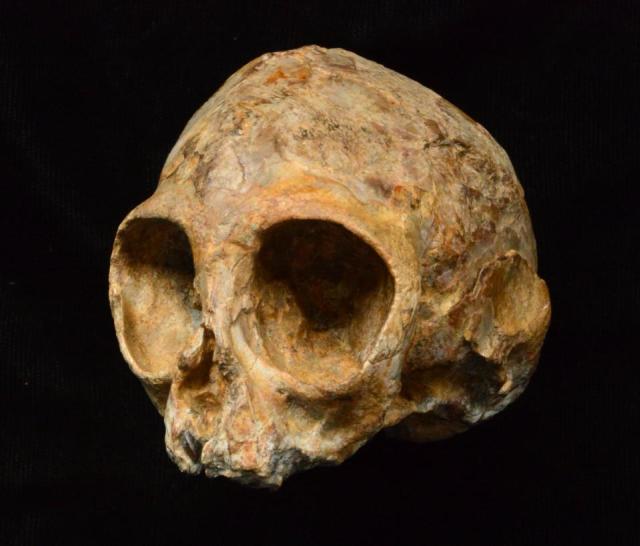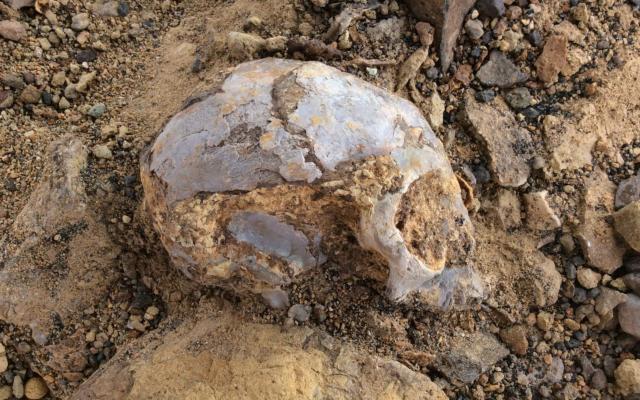Kenya: 13 Million Year-Old Baby Ape Skull Reveals What Human Ancestor May Have Looked Like
 Conor Gaffey,Newsweek 10 hours ago
Conor Gaffey,Newsweek 10 hours ago Anthropologists in Kenya have discovered a 13 million year-old baby ape skull that reveals what the common ancestor of all living humans and apes would have looked like.
The lemon-sized skull was discovered in 2014 at Napudet, a dig site west of Lake Turkana in northern Kenya, according to the study published in Nature on Thursday. It is thought to be the most complete fossil ape skull ever discovered and dates from the Middle Miocene period, a crucial point in the evolutionary history of apes and humans.
 The skull of a newly-identified species, Nyanzapithecus alesi, was discovered in 2014 in northern Kenya. It has been dated to 13 million years old, a crucial period in human evolutionary history. Fred Spoor
The skull of a newly-identified species, Nyanzapithecus alesi, was discovered in 2014 in northern Kenya. It has been dated to 13 million years old, a crucial period in human evolutionary history. Fred Spoor Researchers determined that the skull belonged to a newly-identified species of early ape, which they classified as Nyanzapithecus alesi; the name of the species, alesi , derives from the Turkana word for ancestor.
Its face bears similarities to modern infant gibbons, including a small snout, but the fossil's ear canals are closer to chimpanzees and humans. Alesi, as the fossil was nicknamed, also has a relatively large brain cavity of around seven tablespoons, which is more than double that of its contemporary monkeys. The skull also contains unerupted adult teeth, teeth that have formed but not emerged into the mouth. The researchers used X-ray imaging to reconstruct the teeth, which indicated that the ape belonged to a new species.
 The skull was discovered at the Napudet dig site west of Lake Turkana in northern Kenya. Isaiah Nengo
The skull was discovered at the Napudet dig site west of Lake Turkana in northern Kenya. Isaiah Nengo Don't miss: Lifesaving Heart Drugs Are Being Avoided by U.S. Hospitals After Massive Price Increases
All living humans and apes are thought to derive from a common ancestor; the link between humans and chimpanzees lived in Africa between 6 and 7 million years ago. But the fossil record is scarce prior to 10 million years ago, making it difficult for experts to determine the link between apes and humans.
During the Miocene epoch—which stretches from 23.03 to 5.333 million years ago—apes underwent a period of massive evolutionary change, with more than 40 species appearing. But the epoch has a relatively poor fossil record; prior to the discovery, there were no cranial fossils found in Africa at all dating between 14 and 10 million years ago. Alesi dates from this critical Middle Miocene period.
"Nyanzapithecus alesi was part of a group of primates that existed in Africa for over 10 million years," said Isaiah Nengo, a professor of anthropology at the Turkana Basin Institute, affiliated with Stony Brook University, New York, and De Anza College, San Francisco, who led the study.
"What the discovery of Alesi shows is that this group was close to the origin of living apes and humans and that this origin was African."
Most popular: Manchester United: Defender 'Agrees Five-Year Deal' To Join Jose Mourinho at Old Trafford
 Anthropologists excavate the 13 million year-old baby ape skull at the discovery site. Isaiah Nengo
Anthropologists excavate the 13 million year-old baby ape skull at the discovery site. Isaiah Nengo Nengo and his team took over excavations at the Napudet dig site in 2013 and the discovery was made early the following year. John Ekusi, one of the expedition's assistants, walked away from his colleagues to smoke a cigarette when he noticed something in the ground; Ekusi originally thought it may have been a leg bone from an elephant, but the team soon realized it was a rare find. But since the discovery occurred late in the day, the team had to rebury the skull and excavate it the next morning, National Geographic reported.
To pinpoint where the species should be located in evolutionary history, the team brought the skull to the European Synchrotron Radiation Facility (ESRF) in Grenoble, France. Experts at the ESRF used high-powered, sensitive X-rays to model the inside of the skull.
"We were able to reveal the brain cavity, the inner ears and the unerupted adult teeth with their daily record of growth lines," said Paul Tafforeau of the ESRF. In fact, the images produced by the X-ray technique were so accurate that the team could establish the age at which the infant ape died: 16 months.
The skull was preserved due to a volcanic eruption in its vicinity, which covered it in minerals and ash. The research team is now intending to study the brain impressions on the interior of the skull and use the well-preserved ear canal to reconstruct more accurately how the ape may have looked.
More from Newsweek
The Telegraph  Sarah Knapton,The Telegraph Wed, Aug 9 12:29 PM PDT
Sarah Knapton,The Telegraph Wed, Aug 9 12:29 PM PDT
Meet 'Alesi', the 13-million-year-old baby monkey which scientists say is mankind's earliest ancestor
 Sarah Knapton,The Telegraph Wed, Aug 9 12:29 PM PDT
Sarah Knapton,The Telegraph Wed, Aug 9 12:29 PM PDT 
A baby ape discovered in Kenya could be an example of the earliest ancestors of all living humans, scientists believe.
The little creature, whose skull is roughly the size of a lemon, lived around 13 million years ago and came from a family which may have eventually evolved into man and apes.

It was discovered by Kenyan fossil hunter John Ekusi in ancient rock layers in the Napudet area, west of Lake Turkana, in the north of the country.
The fossil survived because a nearby volcano buried the forest in which it lived millions of years ago, perfectly preserving the skull, even down to the tiny ear canals deep inside its cranium.
All humans and apes alive today come from a common lineage, but until now paleontologists have only managed to trace that line back to 10 million years ago so it was unclear what our ancestors looked liked further back, and if they originated in Africa or elsewhere.
The new specimen has been labelled Nyanzapithecus alesi, with its species name taken from the Turkana word for ancestor - 'ales.' It was just 16 months old when it died.
Mapped: Alesi fossil discovery in Kenya
A handful of bones and teeth had previously been found from the Nyanzapithecus species but scientists were unsure what the creature would have looked like, or how far back it went.
The new skull has a noticeably small snout, like a gibbon, but scans of the inside of the cranium reveal that it had ear tubes which are closer to chimpanzees and humans.
"Gibbons are well known for their fast and acrobatic behavior in trees," said Fred Spoor, Professor of Evolutionary Anatomy at University College London.
"But the inner ears of Alesi show that it would have had a much more cautious way of moving around."

The find is the most complete extinct ape skull known in the fossil record. Humans themselves diverged from apes around six million years later, sharing a last common ancestor with chimpanzees about 7 million years ago.
"Nyanzapithecus alesi was part of a group of primates that existed in Africa for over 10 million years," added lead author Dr Isaiah Nengo, of Stony Brook University.
"What the discovery of Alesi shows is that this group was close to the origin of living apes and humans and that this origin was African."
Co-author Craig Feibel, Professor of Geology and Anthropology at of Rutgers University, New Brunswick, added: "The Napudet locality offers us a rare glimpse of an African landscape 13 million years ago.
"A nearby volcano buried the forest where the baby ape lived, preserving the fossil and countless trees. It also provided us with the critical volcanic minerals by which we were able to date the fossil."
The research was published in the journal Nature.



0 comments:
Post a Comment